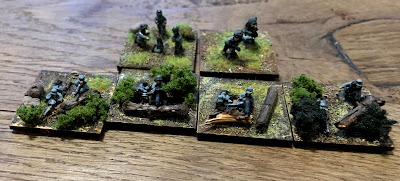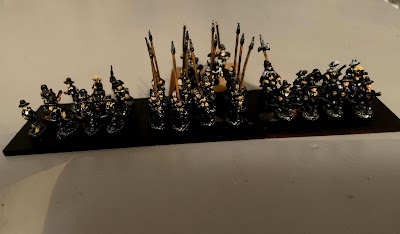So on to the third game this week. Same table, bar a few tweaks. This time I guess the setting is somewhere in western England. Though the name Tyburgh sounds more north-eastern. I should have thought of that before. The split-rail fences were replace with hedges. The woods on the hills were drastically thinned out. The town buildings were given a more 'Jacobean' look. The wood on the low ridge became an orchard and a parish church appeared on the ridge to the south of the town.
Roving Parliamentarian troubleshooter, Colonel Sydenham Hill has been charged with the role of representative of the Committee of Safety and despatched to Hiserfordshire where the local Parliamentary commanders are having trouble holding their own against the Royalist gentry of the county. As well as acting as go between betwixt the Committee and the local association, Hill was to assess the situation and inform the Committee as to whether parliament really needed to despatch more money to the county or if they were faced with trimmers. Was the local association hedging their bets and not prosecuting the war as hard as it should be in case the King should prevail and hold them to account.
Hill was attending upon His Lordship the Earl of Momerset, present with his column some miles south west of the county town of Hiserford towards the Welch Marches. Momerset had a force of three fine regiments of foote, two of the county Trayned Bands, a brigade of splendidly accoutred horse including His Lordship's Lifeguard, and a well-equipped trayn consisting of a demi-cannon, a demi-culverin, 3 sakers, a falconette and 2 robinets. Always fond of his food, and with the figure to show for it, Momerset (later to be played on stage by Robert Morley) was entertaining the relatively ascetic Hill (ascetic by Momerset's standards anyway) to a splendid repast when a letter was delivered by His Lordship's equerry. Hill observed His Lordship's brow begin to glisten, his face flush with the heat of some troublesome humours, then he watched startled* as Momerset began to choke. Too late, Hill and the equerry realised His Lordship's predicament and gazed in horror as apoplexy seized the peer. Within seconds the man's face was slumped on the plate of goose intestines**.
* An unpleasant story was doing the rounds in London during the Protectorate that Hill had deliberately hesitated in coming to the Earl's aid, suspecting the peer of perfidy but unable to prove anything. His Lordship being incapacitated this way would solve the problem. It was further rumoured, after the Restoration, that Hill himself had started the first rumour in order to win favour with the Lord Protector. Naturally Hill denied this and claimed he was merely holding back from rising from his seat out of deference to the Earl. He 'didn't deign to interrupt His Lordship as he appeared to be contemplating some deep matter'.
** I have no idea what gourmands of the 1640s ate, but I'm sure it must have included something as unpleasant sounding as goose goose intestines.
Grasping the letter brought in by the equerry, Hill read the news it bore. The essence of the message was that Lord Pomfrey was on his way with the King's men and would 'expect account to be made from His Lordship for the signal favours showed him by the King.' Hill surmised that the rumours of Momerset's treachery were true and that there was not a moment to lose. He would have to take control of the situation with His Lordship apparently dying, and march to meet Pomfrey. Unfortunately bad news travels fast and the messenger who had delivered his message to Momerset's equerry had by now also repeated it in the camp. The horse didn't wait to try their mettle, knowing the rumours of Momerset's perfidy (why should they risk their necks) and made off over the hills to Hiserford, shortly followed by the trayn. The colonel's of the trayned band regiments promised to meet Hill on the road to Tyburgh, but when he reached the appointed meeting point word reached Hill that the trayned bands had also made their way to Hiserford where they would 'guard the arsenal and hold the city for King and Parliament'. Clearly they were hedging their bets.
All of this is a long-winded explanation of why Sydenham Hill found himself with 3 Batalia of foote at the small town (barely more than a village) of Tyburgh facing the Lord Pomfrey with 5 Battalia*** of foote and two of horse. Hill assessed the situation, and reckoning on secure flanks and the protection of a stout hedge that he could hold Pomfrey at the western marches of the county.
*** My spellchecker keeps wanting to change 'battalia' to Natalia. That would be inconvenient as to my knowledge Pendraken do not make castings of Eastern European gymnasts.
 |
| The prospect before Pomfrey. The road block by gabions. Regiments of foote either side of the road and one in reserve at the town. Orchard on the ridge to the left and church to the right. |
I was using my own ECW rules for this encounter. Quite a long while since I've used them, so I was a bit rusty. I allocated two subordinates to Pomfrey and one to Hill, then diced for each leaders' initiative rating. The result:
Pomfrey 1 (the lowest)
Ponsonby (Royalist chorse) 3
Inglethorpe (Royalist foote) 1
Hill 2 (moderate)
Brindley (Parliament's right wing) 1
So a pretty bad bunch all round. After his initial burst of activity, Hill's disappointing show must have been brought on by the aftereffects of his dinner with Momerset. The first few turns were dicing for allocating 'messengers' to the various commands on each side. The more messengers allocated to a unit and the better the general's initiative rating, the better was the chance of the unit doing what the player wants. Each turn a D4 is rolled to see how many additional messengers each commander can deploy that turn - they move at 30cm each turn down the chain of command. Eventually Pomfrey got the two left hand battalia of foote marching (in column, pikes to the front) toward the hedge.
One unit fixed the attention of the right wing unit of Roundheads whilst the other climbed the hedge and made for the ridge. Something had been lost in the message that this second unit got because they failed to turn right once over the hedge. [In my rules units continue to follow an order until a test is passed to change the order! Or until something stops them] By this time Hill had managed to swing his reserve unit round the ridge and got them to fire on the Royalist flanking unit. This was the thing that stopped the royalist march, luckily for the royalists.
 |
| The royalists attacking from left to right have pinned one Roundhead unit at the hedge. Already a combination of shooting and hand-to-hand has removed the Royalist's pike block. 3 casualties removes a base - the round based figures are casualty markers. The Roundhead reserve unit has come from the town and is ready to open fire. |
Whilst the Roundheads demolish the unit who had made it over the hedge, and pushed back the one at the hedge, more Royalist foote began to bear down on the defenders. Meanwhile the Royalist horse, on their right remain in position fixing the attention of the Roundhead left.
 |
| The rightmost Royalist units heads towards the gap in the defenders' line. The unit adjacent to them has deployed in line hoping to have more luck by engaging the Roundheads in a fire fight. |
Things begin to go really bad for the Royalists. They get the worst of the firefight above the road. Then the unit near the road, accompanied by Pomfrey, reaches the hedge by the barrier. As they begin to hack their way through they are met by the Roundhead reserves who have now been steered into the gap. The Parliamentarian left wing unit opens fire into the flank of the column, whilst the reserve pour shot in from the front. This is too much for flesh and blood. They recoil! And apparently worse, Pomfrey, eschewing his casque in order to be recognised, is laid low by a ball to the temple. (i.e. the Royalists rolled a double on 2D6 after receiving hits on the unit).
There was a turn when the Royalists could get no more messenger figures, which hampered their ability to change orders. I then diced for which of the two sub-commanders would seize control. Fortunately for the Royalists Ponsonby seized command on no authority but that which he displayed. (I diced for it)
Although the firefights and melee on the right had gone the way of the Roundheads, they had begun to pick up dangerous levels of casualties and were forced back from the hedgerow. For a while they remained held back where there was no risk of receiving further losses from shooting. It was beginning to look like a stand-off - i.e. a defensive victory.
 |
| The Roundheads had repulsed all attacks. So far. Most of the Royalist foote is spent. |
There was nothing for it. Noticing the withdrawal of the Roundhead colours on their left, Ponsonby felt one more push might do it. Here was his chance to get noticed by Prince Rupert, and earn the gratitude of the King. First one regiment of horse ('the Blues') was set in motion, then the second ('the Browns'). At worst, the Blues could wear down the Roundhead foote, for the second line to deliver the coup de grace. Then Ponsonby spurred over to Inglethorpe and the foote to urge them on to one last effort.
The Blues were in luck, the Roundheads powder must have been poor for they delivered ineffective salvoes. Slowly the horse hacked their way through the hedge and on to the waiting musketeers (their attack was angled to hit the left shot wing). The foote broke and made their way through the field and then on to Tyburgh. Amazingly the Blues did not pursue, perhaps gaining their breath after the struggle through the hedgerow.
At some point in the centre, Inglethorpe was also shot, but this did not bother Ponsonby. He had horse and foote through the hedgerow now, and only two faltering battalia of foote facing him.The latter let of a pathetic hail of lead before being crashed into by the Blues. They dashed up the ridge into the orchard being ridden down by the Blues whose bloodlust was up, being faced by nothing more deadly than the Roundheads arses. Ponsonby had won the day. A tale to be passed down through the years and to inspire future generations of men who bore that proud name.
 |
| The Roundheads' doom is approaching. |
Sydenham Hill was able to make it back to Hiserford first and was able to get his account to the Committee of Safety in London, with the note he snatched from Momerset's hand, before any other news reached them. Accordingly Hill, who was a trusted observer let us not forget, had his version of events accepted but the Committee and he was cleared of any culpability. Indeed he was lauded for worsting 4 of the King's finest foote regiments (an exaggeration) and ridding Parliament of two nuisances in the form of Pomfrey and Inglethorpe. This did him no harm and later in the year he was handed an independent command in the Eastern Association (see the Lincolnshire Campaign).








































